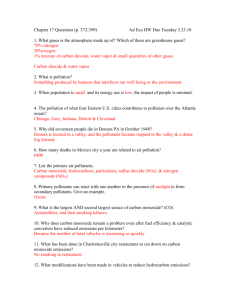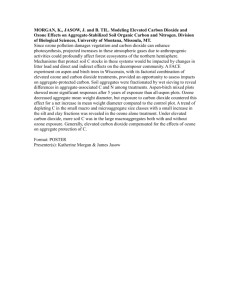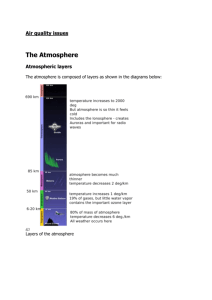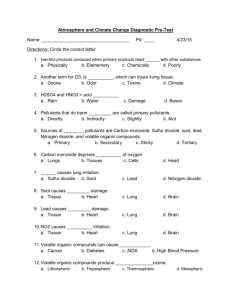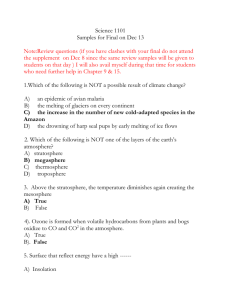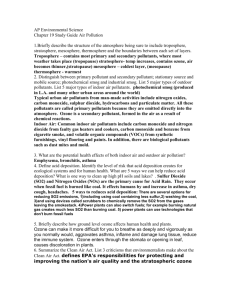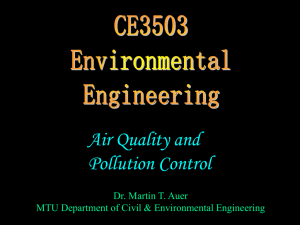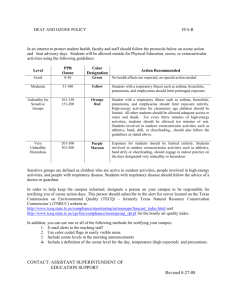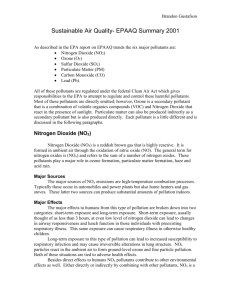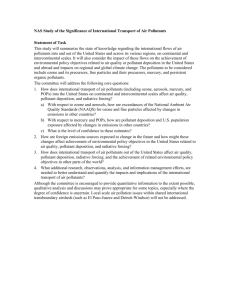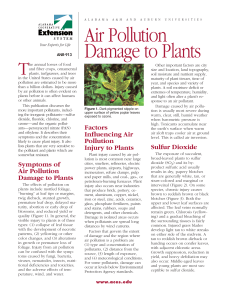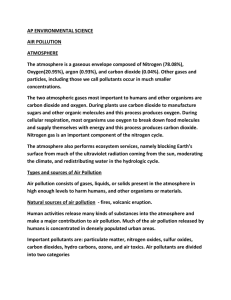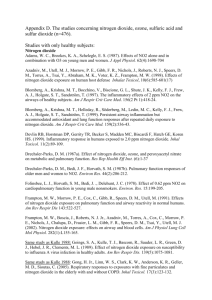Pollutants—How They Affect Humans Carcinogens
advertisement
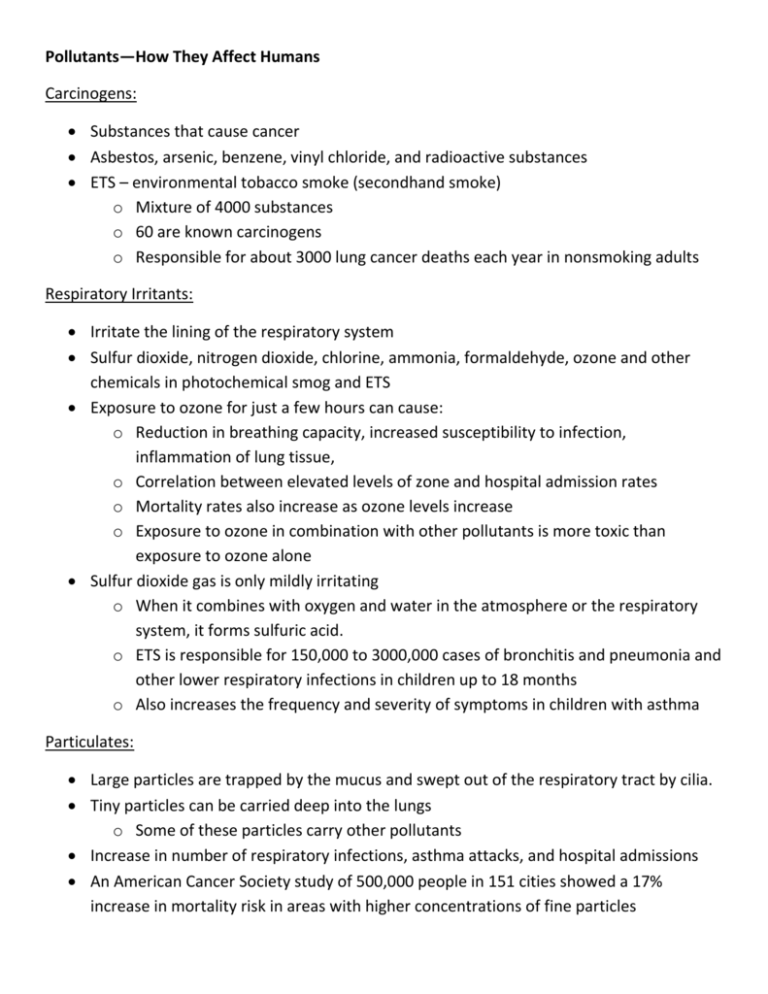
Pollutants—How They Affect Humans Carcinogens: Substances that cause cancer Asbestos, arsenic, benzene, vinyl chloride, and radioactive substances ETS – environmental tobacco smoke (secondhand smoke) o Mixture of 4000 substances o 60 are known carcinogens o Responsible for about 3000 lung cancer deaths each year in nonsmoking adults Respiratory Irritants: Irritate the lining of the respiratory system Sulfur dioxide, nitrogen dioxide, chlorine, ammonia, formaldehyde, ozone and other chemicals in photochemical smog and ETS Exposure to ozone for just a few hours can cause: o Reduction in breathing capacity, increased susceptibility to infection, inflammation of lung tissue, o Correlation between elevated levels of zone and hospital admission rates o Mortality rates also increase as ozone levels increase o Exposure to ozone in combination with other pollutants is more toxic than exposure to ozone alone Sulfur dioxide gas is only mildly irritating o When it combines with oxygen and water in the atmosphere or the respiratory system, it forms sulfuric acid. o ETS is responsible for 150,000 to 3000,000 cases of bronchitis and pneumonia and other lower respiratory infections in children up to 18 months o Also increases the frequency and severity of symptoms in children with asthma Particulates: Large particles are trapped by the mucus and swept out of the respiratory tract by cilia. Tiny particles can be carried deep into the lungs o Some of these particles carry other pollutants Increase in number of respiratory infections, asthma attacks, and hospital admissions An American Cancer Society study of 500,000 people in 151 cities showed a 17% increase in mortality risk in areas with higher concentrations of fine particles Carbon Monoxide: Absorbed by the blood Combines with hemoglobin in the red blood cells more quickly than oxygen It is not given up to the body cells (unlike oxygen) Reduces the ability of hemoglobin to transport oxygen Moderate concentrations cause fatigue, dizziness, impaired judgment, and impaired fetal development People with heart disease are the most affected High concentrations from a leaky car exhaust or a malfunctioning furnace are often fatal Lead: Heavy metal that interferes with the normal activity of the nervous system and the kidneys Enters the body through food, water, skin, or though the air you breathe (most dangerous) Cigarette smoke contains lead o Almost all lead in the lungs enters the blood Children are more affected by air pollution than adults o Spend more time in the environment outdoors o Breathe 3x the amount of air per pound of body weight o Fewer detoxifying enzymes o Body is still developing and their cells are dividing rapidly Effects on Animals Different species of animals react in different ways to pollution 1952 London disaster o Out of 350 cattle being exhibited, 5 died, 52 became ill, 9 had to be destroyed o Sheep swine and horses showed no effects o Bronchitis and pneumonia increased among some animals in the zoo Air pollution disasters that harmed animals were usually downwind from an industry o Plants become coated with air pollutants o Roots absorbed the pollutants o Animals fed on plants 1902 Anaconda, Montana o Arsenic from a copper smelter caused the death of sheep and horses 1954 Sweden o Molybdenum from a steel plant poisoned cattle 1955 Germany o Lead and Zinc from foundries caused cattle and horses to become so lame hat they had to be slaughtered 1967 Montana o Fluoride from a fertilizer plant caused fluorosis in cattle and sheep Teeth became discolored Weight loss Produced less milk Slower growth Bones became deformed and had to be slaughtered 1985 New Jersey Zinc Co Palmerton, Pennsylvania o Cadmium, lead and zinc accumulated in the soil o Grass contained enough zinc to cause lameness in horses o Caused illness and fatigue in cattle and horses Effects on Plants Early 1900s The path of sulfur dioxide fumes from copper smelters could be traced by observing the death of plants o Sulfur dioxide interferes with growth and decreases the yield of some plants, even when no damage is visible. o Plants with thin leaves are more sensitive o Plants with fleshy leaves or needles are more resistant o Damage from sulfur dioxide is greater when there is dew or a light mist. Ozone – natural level is 0.025 ppm o Ozone becomes more toxic in the presence of sulfur dioxide (synergistic effect) o 0.05 ppm for 3 weeks begin to damage corn, soybeans, and winter wheat o 0.25 ppm for 8 months produced broken leaves in orange trees o 0.5 ppm caused chlorosis, the loss of chlorophyll in leaves o Most damaging of the air pollutants affecting agricultural crops and commercial forests Reduces yield of crops like soybeans, wheat, and cotton by interfering with the ability of plants to produce and store food. Makes them more susceptible to diseases, pests, and other environmental stresses Ethylene o Pollutant in car exhaust o Leak from “gas” lamps along city streets causes leaves to drop from trees o Interferes with the opening of some lower buds o Flowers wither or drop off when a few ppb of ethylene are present o Higher concentrations retard the growth of tomatoes Property damage Metals corrode faster in industrialized areas Degree of corrosion is proportional to the amount of pollution Stone is eaten way by pollutants in the atmosphere Sulfur oxides and carbon dioxide o combine with moisture in the air to form acids o Dissolve metals, marble, roofing slate, and mortar in our buildings o Weaken fibers in fabric and leather o Sulfuric acids react with paper making it brittle Historical libraries spend thousands of dollars each year for special air filters to control humidity levels and filter air pollutants Nitrogen oxides and ozone o destroy pigments in paint and fabrics Ozone damages rubber, plastics, and paints
